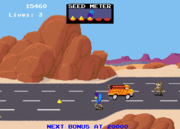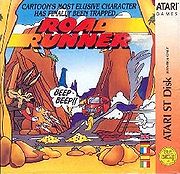.gif)
Road Runner (game)
Encyclopedia
Road Runner is a variant of the platformer
genre, based on the Wile E. Coyote and Road Runner shorts
. It was developed and released by Atari Games
in 1985.
by. In addition to avoiding the coyote, the player must pick up bird seeds on the street, avoid obstacles like cars, and get through mazes. Sometimes Wile E. Coyote will just run after the Road Runner, but he occasionally uses tools like rockets, roller skates, and pogo-sticks. The roller skates are noted for having rockets on them, and are used if the Road Runner gets too far away from Wile E. Coyote. The permanent hunt makes the game very fast-paced and captures the spirit of the cartoon very well.
 The Road Runner dies if the Coyote catches him, he is hit by a car (which pushes him offscreen), steps on a land mine, or if he falls from a cliff. Getting hit by falling boulders will stun him, giving the Coyote a chance to catch up. However, if the Coyote is hit by a boulder while capturing the Road Runner, he will be squashed, and the Road Runner will get another chance. The Road Runner also needs to eat the bird seed, because when he misses 5 of them, he will faint and his opponent can easily get him. The player has three lives initially and can obtain extra lives by reaching a certain number of points. The game does not have an ending, but the landscape repeats after a while, getting more difficult each time.
The Road Runner dies if the Coyote catches him, he is hit by a car (which pushes him offscreen), steps on a land mine, or if he falls from a cliff. Getting hit by falling boulders will stun him, giving the Coyote a chance to catch up. However, if the Coyote is hit by a boulder while capturing the Road Runner, he will be squashed, and the Road Runner will get another chance. The Road Runner also needs to eat the bird seed, because when he misses 5 of them, he will faint and his opponent can easily get him. The player has three lives initially and can obtain extra lives by reaching a certain number of points. The game does not have an ending, but the landscape repeats after a while, getting more difficult each time.
The Road Runner earns points by default by running across the screen, and will earn points for eating birdseed. The values start at 100, and increase to 200, 300, and so forth each time consecutive seed piles are eaten, going up to 1000 points per seed. If the Road Runner misses a seed, the value resets. The Road Runner earns bonus points for drinking lemonade, jumping over land mines, and luring the Coyote into getting defeated, such as leading him into the path of an incoming car, luring him to a land mine (unlike the Road Runner, the Coyote cannot see the mines,) or getting him hit by a boulder. The Coyote's contraptions also backfire at certain parts of each stage, and a bonus is awarded for that as well. The Road Runner game is notable for having classical music that fits the classic chase theme, including the William Tell Overture
, the Nutcracker Suite, and the Saber Dance. When the game ends, the classic Looney Tunes ending theme will play.
 Road Runner was ported to the Amstrad CPC
Road Runner was ported to the Amstrad CPC
, Atari 2600
, Atari ST
, Commodore 64
, DOS
, Sinclair ZX Spectrum
, and NES
. Like other NES games released by Tengen
, the NES version of Road Runner was released in an unlicensed cartridge.
#140 by Hartley, Patricia, and Kirk Lesser in "The Role of Computers" column. The reviewers gave the game 3 out of 5 stars.
Ports
Platform game
A platform game is a video game characterized by requiring the player to jump to and from suspended platforms or over obstacles . It must be possible to control these jumps and to fall from platforms or miss jumps...
genre, based on the Wile E. Coyote and Road Runner shorts
Wile E. Coyote and Road Runner
Wile E. Coyote and The Road Runner are a duo of cartoon characters from a series of Looney Tunes and Merrie Melodies cartoons. The characters were created by animation director Chuck Jones in 1948 for Warner Bros., while the template for their adventures was the work of writer Michael Maltese...
. It was developed and released by Atari Games
Atari Games
Atari Games Corporation was an American producer of arcade games, and originally part of Atari, Inc..-History:When, in 1984, Warner Communications sold the Atari Consumer division of Atari Inc...
in 1985.
Gameplay
The player controls Road Runner, who is chased by Wile E. Coyote. In order to escape, Road Runner runs endlessly to the left while the landscape scrollsScrolling
In computer graphics, filmmaking, television production, and other kinetic displays, scrolling is sliding text, images or video across a monitor or display. "Scrolling", as such, does not change the layout of the text or pictures, or but incrementally moves the user's view across what is...
by. In addition to avoiding the coyote, the player must pick up bird seeds on the street, avoid obstacles like cars, and get through mazes. Sometimes Wile E. Coyote will just run after the Road Runner, but he occasionally uses tools like rockets, roller skates, and pogo-sticks. The roller skates are noted for having rockets on them, and are used if the Road Runner gets too far away from Wile E. Coyote. The permanent hunt makes the game very fast-paced and captures the spirit of the cartoon very well.

The Road Runner earns points by default by running across the screen, and will earn points for eating birdseed. The values start at 100, and increase to 200, 300, and so forth each time consecutive seed piles are eaten, going up to 1000 points per seed. If the Road Runner misses a seed, the value resets. The Road Runner earns bonus points for drinking lemonade, jumping over land mines, and luring the Coyote into getting defeated, such as leading him into the path of an incoming car, luring him to a land mine (unlike the Road Runner, the Coyote cannot see the mines,) or getting him hit by a boulder. The Coyote's contraptions also backfire at certain parts of each stage, and a bonus is awarded for that as well. The Road Runner game is notable for having classical music that fits the classic chase theme, including the William Tell Overture
William Tell Overture
The William Tell Overture is the instrumental introduction to the opera Guillaume Tell by Gioachino Rossini. William Tell premiered in 1829 and was the last of Rossini's 39 operas, after which he went into semi-retirement, although he continued to compose cantatas, sacred music and secular vocal...
, the Nutcracker Suite, and the Saber Dance. When the game ends, the classic Looney Tunes ending theme will play.
Ports

Amstrad CPC
The Amstrad CPC is a series of 8-bit home computers produced by Amstrad between 1984 and 1990. It was designed to compete in the mid-1980s home computer market dominated by the Commodore 64 and the Sinclair ZX Spectrum, where it successfully established itself primarily in the United Kingdom,...
, Atari 2600
Atari 2600
The Atari 2600 is a video game console released in October 1977 by Atari, Inc. It is credited with popularizing the use of microprocessor-based hardware and cartridges containing game code, instead of having non-microprocessor dedicated hardware with all games built in...
, Atari ST
Atari ST
The Atari ST is a home/personal computer that was released by Atari Corporation in 1985 and commercially available from that summer into the early 1990s. The "ST" officially stands for "Sixteen/Thirty-two", which referred to the Motorola 68000's 16-bit external bus and 32-bit internals...
, Commodore 64
Commodore 64
The Commodore 64 is an 8-bit home computer introduced by Commodore International in January 1982.Volume production started in the spring of 1982, with machines being released on to the market in August at a price of US$595...
, DOS
DOS
DOS, short for "Disk Operating System", is an acronym for several closely related operating systems that dominated the IBM PC compatible market between 1981 and 1995, or until about 2000 if one includes the partially DOS-based Microsoft Windows versions 95, 98, and Millennium Edition.Related...
, Sinclair ZX Spectrum
ZX Spectrum
The ZX Spectrum is an 8-bit personal home computer released in the United Kingdom in 1982 by Sinclair Research Ltd...
, and NES
Nintendo Entertainment System
The Nintendo Entertainment System is an 8-bit video game console that was released by Nintendo in North America during 1985, in Europe during 1986 and Australia in 1987...
. Like other NES games released by Tengen
Tengen
Tengen may refer to:*Tengen , the center point on a Go board, and the name of a Go competition in Japan*Tengen , a city in Baden-Württemberg, Germany*Tengen , a defunct video game publisher and developer...
, the NES version of Road Runner was released in an unlicensed cartridge.
Reception
The game was reviewed in 1988 in DragonDragon (magazine)
Dragon is one of the two official magazines for source material for the Dungeons & Dragons role-playing game and associated products, the other being Dungeon. TSR, Inc. originally launched the monthly printed magazine in 1976 to succeed the company's earlier publication, The Strategic Review. The...
#140 by Hartley, Patricia, and Kirk Lesser in "The Role of Computers" column. The reviewers gave the game 3 out of 5 stars.
External links
ArcadePorts

